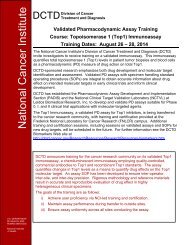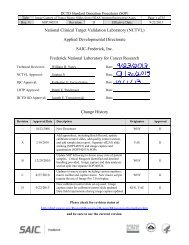National Cancer Institute - NCI Division of Cancer Treatment and ...
National Cancer Institute - NCI Division of Cancer Treatment and ...
National Cancer Institute - NCI Division of Cancer Treatment and ...
Create successful ePaper yourself
Turn your PDF publications into a flip-book with our unique Google optimized e-Paper software.
significance <strong>of</strong> Akt activation in NSCLC<br />
tumors. Collaboration <strong>of</strong> Drs. Joanna<br />
Shih, BRB, Jin Jen, CCR Laboratory <strong>of</strong><br />
Population Genetics, <strong>and</strong> Phillip A.<br />
Dennis, CCR <strong>Cancer</strong> Therapeutics Branch.<br />
■ Ingenuity network assisted transcription<br />
pr<strong>of</strong>iling: identification <strong>of</strong> a new pharmacological<br />
mechanism for MK886.<br />
Collaboration <strong>of</strong> Drs. Shih, BRB, <strong>and</strong><br />
Anatoly L. Mayburd, CCR Cell <strong>and</strong><br />
<strong>Cancer</strong> Biology Branch.<br />
■ Desmoglein 3 as a prognostic indicator<br />
in lung cancer. Collaborators are<br />
Drs. Shih, BRB, <strong>and</strong> Jen.<br />
■ Cross-species comparisons <strong>of</strong> mouse<br />
mammary tumor models <strong>and</strong> human<br />
breast cancer by expression pr<strong>of</strong>iling:<br />
identification <strong>of</strong> luminal <strong>and</strong> basal<br />
phenotypes <strong>and</strong> a conserved gene<br />
signature discriminating estrogenreceptor-positive<br />
from estrogenreceptor-negative<br />
tumors. Collaboration<br />
<strong>of</strong> Drs. Shih <strong>and</strong> Jeff Green, CCR<br />
Laboratory <strong>of</strong> Cell Regulation <strong>and</strong><br />
Carcinogenesis.<br />
■ Histological staining method preparatory<br />
to laser capture microdissection<br />
significantly affects detection <strong>of</strong> mRNAs<br />
in microarray hybridization. Collaboration<br />
<strong>of</strong> Drs. Shih <strong>and</strong> Frederic Mushinski,<br />
CCR Laboratory <strong>of</strong> Genetics.<br />
■ Identifying the sequential alterations<br />
<strong>of</strong> the genome, transcriptome, <strong>and</strong><br />
proteome that define the transformation<br />
<strong>of</strong> normal colon epithelium <strong>and</strong><br />
the progression from adenomas to<br />
invasive disease. Collaboration <strong>of</strong><br />
Drs. Lisa McShane <strong>and</strong> Ed Korn, BRB,<br />
with Thomas Ried <strong>and</strong> others <strong>of</strong><br />
the CCR <strong>Cancer</strong> Genomics Section<br />
<strong>of</strong> the Genetics Branch.<br />
■ Effectiveness <strong>of</strong> gene expression pr<strong>of</strong>iling<br />
for response prediction <strong>of</strong> rectal<br />
adenocarcinomas in preoperative<br />
chemoradiotherapy. Collaboration <strong>of</strong><br />
Drs. Sudhir Varma <strong>and</strong> Richard Simon,<br />
BRB, with Ried <strong>and</strong> his colleagues.<br />
■ Selective utilization <strong>of</strong> the Wnt/<br />
b-catenin signaling pathway <strong>and</strong><br />
aneuploidy-dependent massive<br />
deregulation <strong>of</strong> the cellular transcriptome<br />
in human rectal carcinomas.<br />
Collaboration <strong>of</strong> Drs. Varma <strong>and</strong> Simon,<br />
BRB, with Ried <strong>and</strong> colleagues.<br />
Dr. Thomas Ried, CCR Genetics Branch.<br />
Network mapping <strong>of</strong> genes involved in rectal tumorigenesis. Shades <strong>of</strong> red<br />
indicate genes with five-fold or greater expression in the tumors; shades <strong>of</strong><br />
green indicate genes with a more than five-fold decrease in expression in<br />
the tumors relative to the normal rectal mucosa.<br />
B I O M E T R I C R E S E A R C H B R A N C H ■ 15










